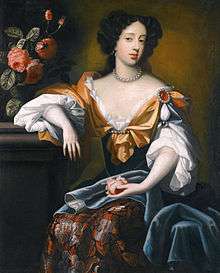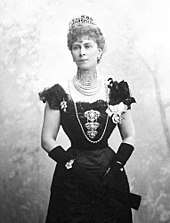Duchess of York
Duchess of York is the principal courtesy title held by the wife of the Duke of York. Three of the eleven Dukes of York either did not marry or had already assumed the throne prior to marriage, whilst two of the dukes married twice, therefore there have been only ten Duchesses of York.
Duchesses of York
The ten Duchesses of York (and the dates the individuals held that title) are as follows:
| Person | Name | Birth | Marriage | Became Duchess of York | Spouse | Ceased to be Duchess of York | Death |
|---|---|---|---|---|---|---|---|
| Infanta Isabella of Castile | 1355 | 11 July 1372 | 6 August 1385 | Edmund of Langley | 23 December 1392 | ||
| Lady Joan Holland[lower-alpha 1] | 1380 | 4 November 1393 | 1 August 1402 Husband's death; became Dowager Duchess of York |
12 April 1434 | |||
 |
Philippa de Mohun[lower-alpha 2] | before 7 October 1398 | 1 August 1402 | Edward of Norwich | 25 October 1415 Husband's death; became Dowager Duchess of York |
17 July 1431 | |
 |
Lady Cecily Neville[lower-alpha 3] | 3 May 1415 | October 1429 (or earlier) | Richard Plantagenet | 30 December 1460 Husband's death; became Dowager Duchess of York |
31 May 1495 | |
| Anne de Mowbray[lower-alpha 4] | 10 December 1472 | 15 January 1478 | Richard of Shrewsbury | 19 November 1481 | |||
| Anne Hyde[lower-alpha 5] | 12 March 1637 | 3 September 1660 | James Stuart | 31 March 1671 | |||
 |
Princess Mary of Modena[lower-alpha 6] | 5 October 1658 | 21 November 1673 | 6 February 1685 Husband acceded to throne as James II; became Queen Consort |
7 May 1718 | ||
 |
Princess Mary of Teck[lower-alpha 7] | 26 May 1867 | 6 July 1893 | Prince George | 6 May 1910 Husband acceded to throne as George V; became queen |
24 March 1953 | |
.jpg) |
Lady Elizabeth Bowes-Lyon[lower-alpha 8] | 4 August 1900 | 26 April 1923 | Prince Albert | 11 December 1936 Husband acceded to throne as George VI; became queen |
30 March 2002 | |
 |
Sarah Ferguson[lower-alpha 9] | 15 October 1959 | 23 July 1986 | Prince Andrew | 30 May 1996 Divorced; assumed the style of Sarah, Duchess of York |
||
In 1791, Princess Frederica Charlotte of Prussia (1791–1820) married Prince Frederick, Duke of York and Albany (second son of King George III); she thus became HRH The Duchess of York and Albany. Her husband held one double dukedom (of York and Albany) rather than two. The Duchess received a warm welcome to Great Britain but following a troubled relationship with her husband, the couple separated. The two previous Dukes of York and Albany had never married; since her husband was the last Duke of York and Albany, Frederica was the only Duchess with that double title.
Duchess of York eponyms
Ships
- HMS Duchess of York (1801), built in Calcutta in 1801 and wrecked off Madagascar in 1811.[1]
- HMS Duchess of York (1898), a paddle steamer built by Barclay, Curle & Co. Ltd., Glasgow, used as a First World War minesweeper. Later renamed Duchess of Cornwall to allow for a new ship to take its name.[2]
- SS Duchess of York (1928), a steam turbine ocean liner built by John Brown & Co Ltd., Clydebank for Canadian Pacific Steamships. Sunk after being bombed in 1943.[3]
Other
- Duchess of York Ward, opened in 1935 at the Royal Hospital and Home for Incurables.[4]
Notes
- ↑ Joan survived her husband and went on to marry three other noblemen: William de Willoughby, 5th Lord Willoughby de Eresby; Henry Scrope, 3rd Baron Scrope of Masham; and Henry Bromflete, 1st Lord Vessy.
- ↑ A twice widowed noblewoman, she married Edward of Norwich, 2nd Duke of York, Duke of Albemarle. Her two previous husbands were Walter FitzWalter and Sir John Golafre.
- ↑ Cecily survived her husband and all four sons, entering into a largely religious life and dying in 1495 after receiving a papal indulgence.
- ↑ Anne was the child bride of Richard of Shrewsbury, one of the Princes in the Tower. She did not survive her young husband and died at the age of nine.
- ↑ Anne predeceased her husband James before he became King, having contracted breast cancer. Her Protestant daughters became, successively, Queen Mary II and Queen Anne; since James was also Duke of Albany, Lady Anne was both Duchess of York and Duchess of Albany.
- ↑ Later Queen Mary, the second wife of James II of England. Although she was a Roman Catholic and bore him a son James Francis Edward Stuart, because of his religion he did not succeed and instead was supplanted jointly by her stepdaughter Mary II and Mary II's husband William III. Mary of Modena's direct descendants were known as the Jacobites and remain so to this day. Mary was also both Duchess of York and Duchess of Albany.
- ↑ Princess Mary became Duchess of Cornwall and York when her grandmother-in-law Queen Victoria died on 22 January 1901 and her husband became heir apparent. On 9 November of that year she became Princess of Wales when her husband was created Prince of Wales. Princess Mary became queen consort on 6 May 1910 when her husband succeeded to the throne as George V.
- ↑ Known as The Smiling Duchess, she became queen consort when her husband succeeded to the throne on 10 December 1936 as George VI following the abdication of his elder brother, Edward VIII.
- ↑ Sarah was introduced to the second eldest son of Queen Elizabeth II, Prince Andrew, whom she married on 23 July 1986. Following their high-profile marriage and divorce, she became known as "Sarah, Duchess of York" (the proper address for divorced wives of peers). In addition, she lost the style of Royal Highness as well as all other dignities related to the title of British princess. It is also important to note that since their divorce, it is merely a courtesy style which she holds and that she is no longer the Duchess of York (this title would be accorded to any future wife of Prince Andrew). Therefore, she is also not a peeress nor entitled to the style 'Her Grace'. If Sarah, Duchess of York remarries, any use of the style Duchess of York will be lost permanently.
References
- ↑ John Phipps (1840). A Collection of Papers Relative to Ship Building in India ... Scott. p. 99. Retrieved 28 December 2017.
- ↑ "Paddle Steamer Duchess of York". Caledonian Maritime Research Trust. Retrieved 28 December 2017.
- ↑ "Steam Turbine Duchess of York". Caledonian Maritime Research Trust. Retrieved 28 December 2017.
- ↑ Gordon Charles Cook (2006). The Incurables Movement: An Illustrated History of the British Home. Radcliffe Publishing. p. 152. ISBN 9781846190827. Retrieved 28 December 2017.
Bibliography
- ThePeerage.com; A source for peerage information
- Deborah C. Fisher (2005). Princesses of Wales. University of Wales Press. ISBN 9780708319369.